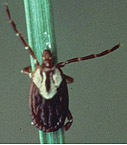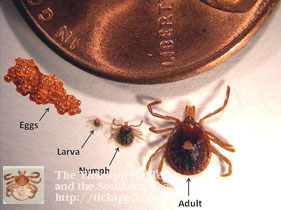
Ticks represent a successful group of parasitic arthropods that are more closely related to mites, spiders, and scorpions than to insects. These destructive blood-feeding organisms are capable of persisting within a variety of environments worldwide, and when necessary, can survive for extended periods of time (2-3 yrs) without feeding. The life cycles of ticks consist of four distinct stages; the egg, six-legged larva, eight-legged nymph, and adult.

Ticks utilize many different feeding strategies to complete their life cycles. The most common strategy requires three separate hosts (the so-called three-host ticks), one each for the larval, nymphal, and adult life stages. Host blood provides the nutrition needed for ticks to molt to the next stage, or to produce eggs for the next generation.

